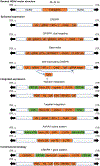Adenovirus vectors in hematopoietic stem cell genome editing
- PMID: 31705806
- PMCID: PMC10473235
- DOI: 10.1002/1873-3468.13668
Adenovirus vectors in hematopoietic stem cell genome editing
Abstract
Genome editing of hematopoietic stem cells (HSCs) represents a therapeutic option for a number of hematological genetic diseases, as HSCs have the potential for self-renewal and differentiation into all blood cell lineages. This review presents advances of genome editing in HSCs utilizing adenovirus vectors as delivery vehicles. We focus on capsid-modified, helper-dependent adenovirus vectors that are devoid of all viral genes and therefore exhibit an improved safety profile. We discuss HSC genome engineering for several inherited disorders and infectious diseases including hemoglobinopathies, Fanconi anemia, hemophilia, and HIV-1 infection by ex vivo and in vivo editing in transgenic mice, nonhuman primates, as well as in human CD34+ cells. Mechanisms of therapeutic gene transfer including episomal expression of designer nucleases and base editors, transposase-mediated random integration, and targeted homology-directed repair triggered integration into selected genomic safe harbor loci are also reviewed.
Keywords: CRISPR/Cas9; HSCs; adenovirus vector; base editors; genome editing; in vivo transduction; targeted integration.
© 2019 Federation of European Biochemical Societies.
Figures


References
-
- Aposhian HV (1970) The use of DNA for gene therapy–the need, experimental approach, and implications. Perspect Biol Med 14, 98–108. - PubMed
-
- Friedmann T and Roblin R (1972) Gene therapy for human genetic disease? Science 175, 949–955. - PubMed
-
- Mann R, Mulligan RC and Baltimore D (1983) Construction of a retrovirus packaging mutant and its use to produce helper-free defective retrovirus. Cell 33, 153–159. - PubMed
-
- Aiuti A, Cattaneo F, Galimberti S, Benninghoff U, Cassani B, Callegaro L, Scaramuzza S, Andolfi G, Mirolo M, Brigida I et al. (2009) Gene therapy for immunodeficiency due to adenosine deaminase deficiency. N Engl J Med 360, 447–458. - PubMed
-
- Cavazzana-Calvo M, Hacein-Bey S, de Saint Basile G, Gross F, Yvon E, Nusbaum P, Selz F, Hue C, Certain S, Casanova JL et al. (2000) Gene therapy of human severe combined immunodeficiency (SCID)-X1 disease. Science 288, 669–672. - PubMed
Publication types
MeSH terms
Grants and funding
LinkOut - more resources
Full Text Sources
Other Literature Sources
Medical

